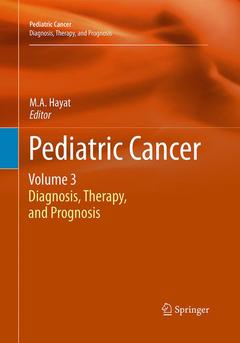Description
Pediatric Cancer, Volume 3, Softcover reprint of the original 1st ed. 2012
Diagnosis, Therapy, and Prognosis
Pediatric Cancer Series, Vol. 3
Coordinator: Hayat M.A.
Language: English
Subjects for Pediatric Cancer, Volume 3:
Publication date: 08-2016
Support: Print on demand
Publication date: 06-2012
301 p. · 17.8x25.4 cm · Paperback
Description
/li>Contents
/li>Comment
/li>
Brain tumors are the most common solid tumor of childhood as well as the leading cause of cancer-related mortality in children. This third volume of the Springer series discussing pediatric cancer focuses on diagnosing, treating, and assessing the future course of malignant brain neoplasms in children. In addition to a general introduction to the principals involved, the material includes vital research in molecular genetics, a major contribution to the molecular characterization of solid tumors, which will define new biomarkers of the disease and identify molecular pathways. Now it has become possible to achieve the goal of targeting new, more effective therapies to minimize the tragedy faced by children. This research features the application of molecular genetics in combating atypical teratoid/rhabdoid tumor (AT/RT), a highly aggressive embryonal CNS tumor that is among the most common malignant neoplasms in children, with a peak occurrence in infants younger than three years old.
Contributors also examine the reasons for the common misdiagnosis of AT/RT tumors as other types of CNS tumors. They help resolve this issue by indicating the details of an abnormality in the genetics of AT/RT, which is unique to AT/RT type. The INII gene on chromosome 22q11 is involved in the AT/RT. The presence of this gene and the SMARCB1 is discussed. In addition to discussing these important topics, the volume includes presentations of present and future therapies. The volume also explains AT/RT?s dissemination to the cerebral fluid, the molecular mechanisms underlying the progression of medulloblastoma, and the importance of gamma knife radiosurgery during multimodality management of medulloblastoma/PNET tumors. Other topics discussed include using magnetic resonance imaging for diagnosing retinoblastoma, and mapping the effects of radiotherapy in low-grade glioma in children. Information on alterations in cell-cycle regulators that are influenced by tumor suppressor genes and oncogenes is detailed. Contributors provide recommendations concerning non-narcotic analgesic routines for children recovering from cranial and spinal surgery. The practical knowledge of frontier-expanding research presented leads this authoritative volume to be a compelling addition to the literature.
I. Teratoid/rhabdoid.
1. Early childhood atypical teratoid/rhabdoid tumors.
2. Atypical teratoid/rhabdoid tumors.
3. Pediatric teratoid/rhabdoid tumours: deletion of chromosome 22q11.2.
4. Pediatric atypical teratoid/rhabdoid tumor: role of ini1 tumor suppressor gene.
5. Atypical teratoid/rhabdoid tumors: diagnosis using imaging.
6. Pediatric atypical teratoid/rhabdoid tumor in the spine: diagnosis and treatment.
7. Early childhood clival-c2 atypical teratoid/rhabdoid tumor: gross total resection followed by aggressive chemotherapy and radiation.
8. Pediatric atypical teratoid/rhabdoid tumors: dissemination to the cerebrospinal fluid.
Ii. Medulloblastoma
9. Teratoid pediatric medullomyoblastoma.
10. Pediatric medulloblastoma: mechanisms of initiation and progression.
11. Medulloblastoma initiation and growth: role of hepatocyte growth factor.
12. Medulloblastoma – molecular genetics.
13. Pediatric medulloblastoma: the role of heterozygous germ-line mutations in the nbn gene.
14. Pediatric medulloblastoma: pituitary adenylyl cyclase activating peptide/protein kinase a antagonism of hedgehog signaling.
15. Medulloblastoma: role of mycn gene amplification using fluorescence in situ hybridization and real time quantitative pcr methods.
16. Pediatric medulloblastoma: ultrastructure.
17. Pediatric medullomyoblastoma: immunohistochemical analyses.
18. Boost gamma knife radiosurgery during multimodality management of medulloblastoma / pnet tumors.
19. Early childhood medulloblastoma: prognostic factors.
Iii. Retinoblastoma
20. Trilateral retinoblastoma: diagnosis using magnetic resonance
imaging.
21. Pediatric intraocular retinoblastoma: treatment.
Iv. Glioma
22. Pediatric high-grade glioma: role of microsatellite instability.
23. Low-grade glioma in children: effects of radiotherapy.
V. Spinal tumors
24. Pediatric multiple primary cranio-spinal tumors associated with neurofibromatosis type 2: combined therapeutical strategies.25. Pediatric intradural lipoma of the cervicothoracic spinal cord: laminectomy and duraplasty.
Vi. Miscellaneous tumors
26. Pediatric embryonal tumors: prognostic role of cyclin a and b1 proteins.
27. Intracranial pediatric ependymoma: role of cytogenetic markers using comparative genomic hybridization and fluorescent in situ hybridization.
28. Pediatric hepatoblastoma. Complete surgery and ultrasound monitoring.
29. Treatment of pineal region tumors in childhood.
30. Benign testicular tumors in children: testicular preserving surgery.
Results of treatments are also presented in color figures
Various therapies against cancer are explained
Most recent diagnostic and therapeutic information is provided
Information on the development of new, more effective drugs is included
Translational and personal target treatments are given
These books may interest you

Posterior Fossa Tumors in Children 273.25 €



